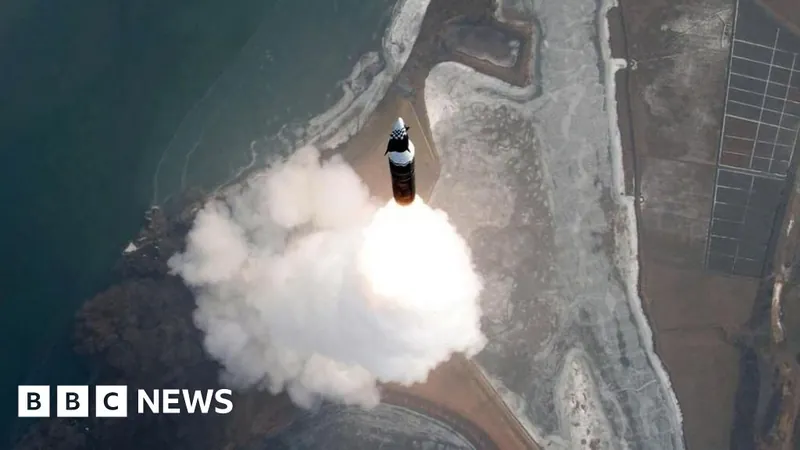
North Korea Launches New Hypersonic Missile, Escalating Tensions in the Pacific
2025-01-07
Author: Lok
In a bold move that has sent ripples through the Pacific region, North Korea has announced the successful launch of a new intermediate-range ballistic missile equipped with a hypersonic warhead. This development comes alongside claims from Pyongyang that the missile is designed to "reliably contain any rivals in the Pacific," a statement that underscores the North's growing assertiveness amid increasing geopolitical tensions.
This missile launch, which took place on Monday, is notable as it marks North Korea's first missile test in two months. The timing coincided with US Secretary of State Antony Blinken's visit to Seoul, where he held discussions with key South Korean leaders regarding regional security and North Korea's weapons programs. The launch has raised alarm bells in South Korea, whose military reported that the missile traveled approximately 1,100 kilometers before plunging into the sea. They have condemned this act as a "clear act of provocation."
North Korea's hypersonic missile capabilities have been a focus of concern due to their flight speed; they can maneuver through the atmosphere at more than five times the speed of sound. Remarkably, North Korea claims that this latest missile achieved speeds of 12 times that of sound and flew for about 1,500 kilometers, showcasing advancements that could challenge existing missile defense systems.
The pictures released by the state news agency KCNA reveal that the missile bears similarities to one tested last April; however, North Korea asserts that this latest version is enhanced with a new "flight and guidance control system" as well as an innovative carbon fiber engine, which potentially increases its durability and effectiveness.
Experts in nuclear weaponry, such as Ankit Panda from the Carnegie Endowment for International Peace, express that the ongoing missile advancements were to be expected. He remarks, “Better materials can increase the odds of their survival to the target,” emphasizing the ongoing improvements in North Korea's missile capabilities.
Despite the threat hypersonic missiles pose, there is a glimmer of hope as some military reports suggest that certain existing technologies might be developed to intercept such weapons, particularly during the final phase of their flight when they are approaching slower speeds.
Adding to the tension, during his visit to Seoul, Secretary Blinken expressed concerns about the potential collaboration between Russia and North Korea regarding advanced space and satellite technology. He indicated that Moscow may be close to altering its long-standing position on denuclearization concerning the Korean Peninsula, potentially recognizing North Korea as a legitimate nuclear power.
South Korea's military has ramped up surveillance capabilities in response to these provocations and is actively sharing intelligence with the United States and Japan to monitor future missile tests from the North.
This missile launch is occurring against a backdrop of political turmoil in South Korea following the impeachment of suspended President Yoon Suk Yeol. His controversial attempts at enforcing martial law have led to significant public dissent, and North Korea has ridiculed this move, labeling it an "insane act."
As one of the world's most oppressive regimes, North Korea's leadership under Kim Jong Un continues to promote a rigid cult of personality, maintaining tight control over its populace while pursuing aggressive military advancements. This missile launch may be just the latest chapter in a complex narrative of regional tension, with the potential for serious implications for peace and stability in the Pacific.
As the geopolitical landscape shifts, the international community watches closely. Will North Korea's new capabilities lead to an arms race in the region? Only time will tell.


 Brasil (PT)
Brasil (PT)
 Canada (EN)
Canada (EN)
 Chile (ES)
Chile (ES)
 Česko (CS)
Česko (CS)
 대한민국 (KO)
대한민국 (KO)
 España (ES)
España (ES)
 France (FR)
France (FR)
 Hong Kong (EN)
Hong Kong (EN)
 Italia (IT)
Italia (IT)
 日本 (JA)
日本 (JA)
 Magyarország (HU)
Magyarország (HU)
 Norge (NO)
Norge (NO)
 Polska (PL)
Polska (PL)
 Schweiz (DE)
Schweiz (DE)
 Singapore (EN)
Singapore (EN)
 Sverige (SV)
Sverige (SV)
 Suomi (FI)
Suomi (FI)
 Türkiye (TR)
Türkiye (TR)
 الإمارات العربية المتحدة (AR)
الإمارات العربية المتحدة (AR)